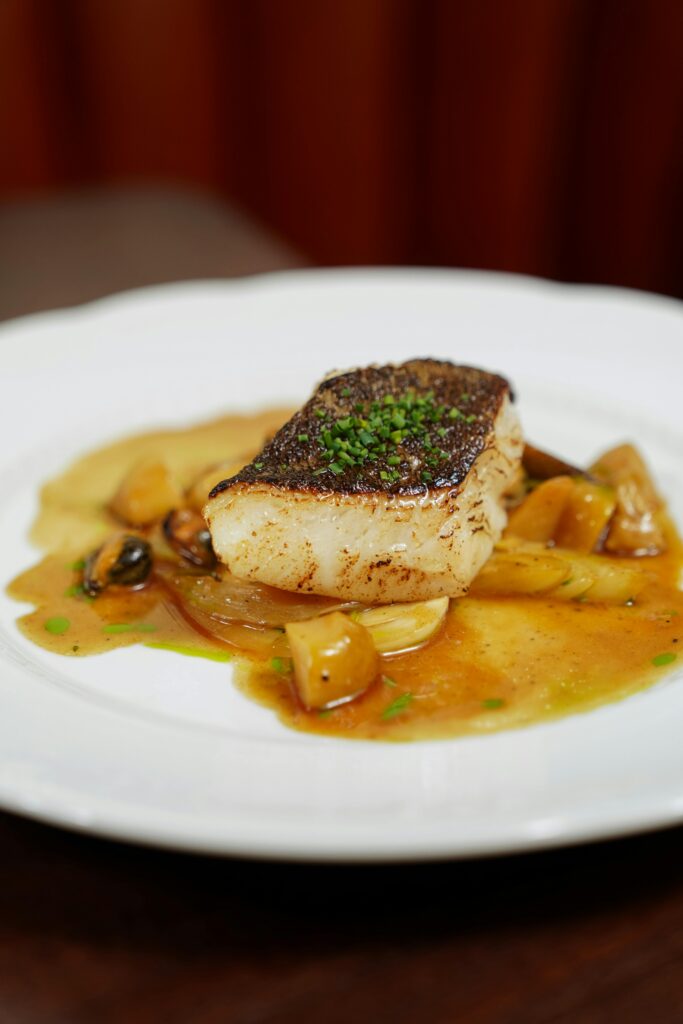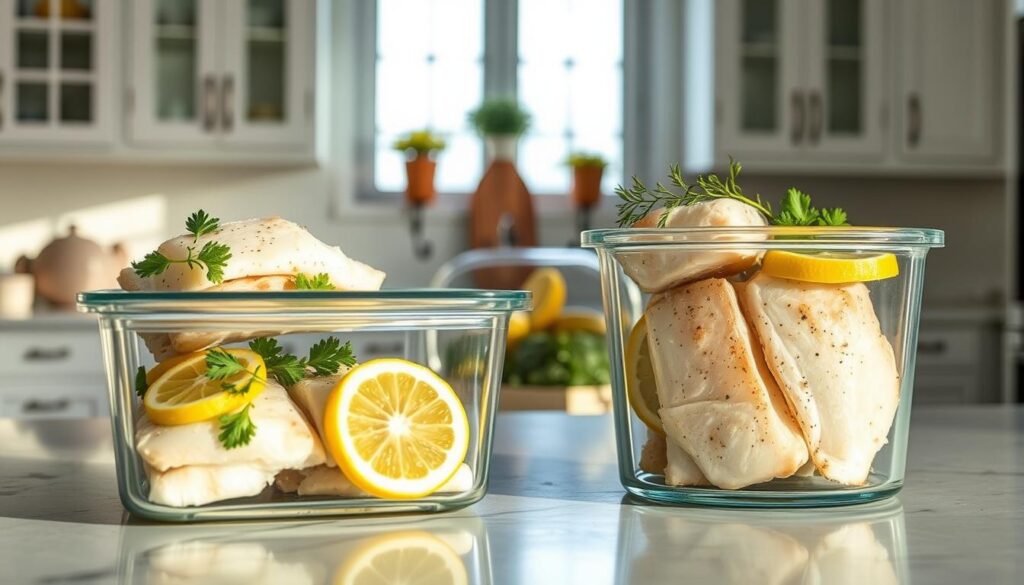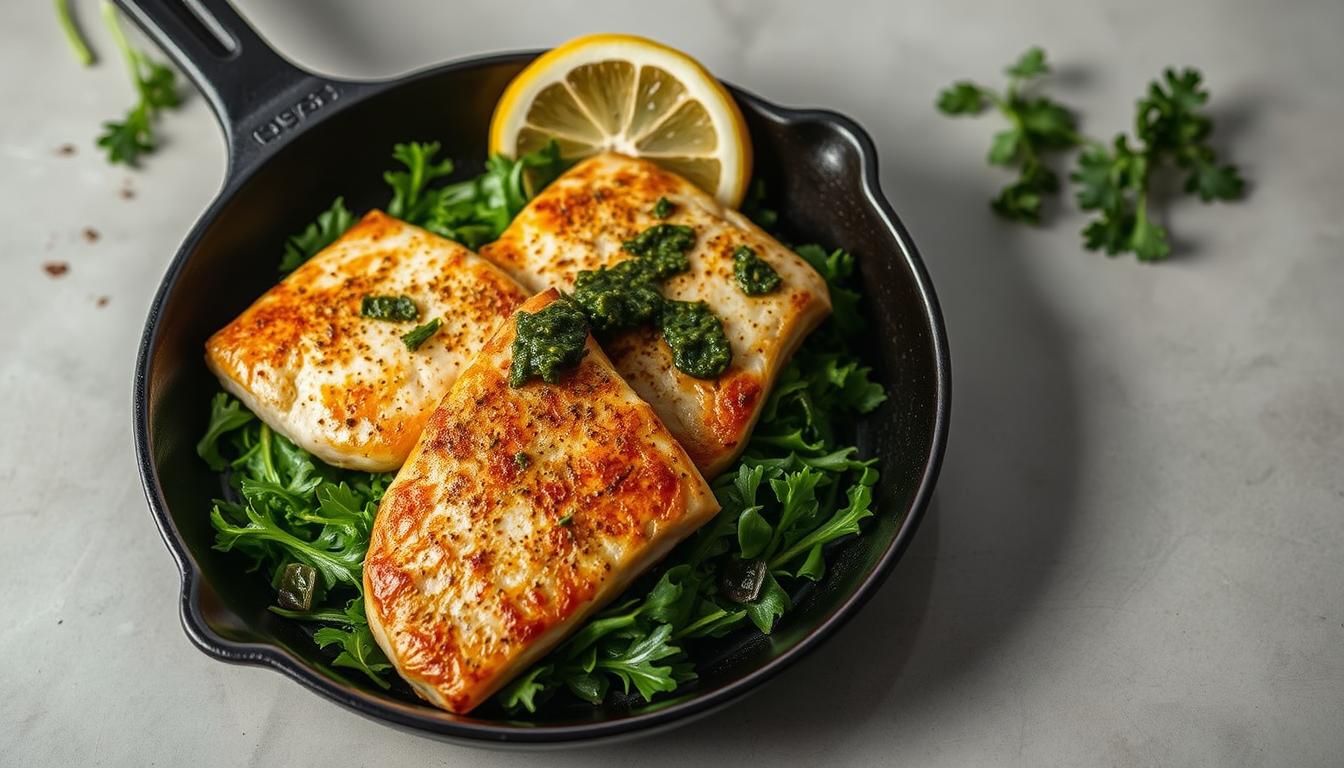Looking for a tasty seafood dish that’s quick to make? Pan-seared tilapia is your go-to! It brings restaurant-quality taste to your kitchen in just 10 minutes.
Pan-Seared Tilapia is a simple yet elegant meal choice. It’s perfect for busy people or cooking enthusiasts. This recipe makes a nutritious and delicious dinner that will wow your loved ones.
With just a few ingredients and easy steps, you can turn a basic fish fillet into a crispy, golden dish. Get ready to boost your cooking skills and enjoy a healthy, tasty seafood meal.
Table of Contents
Introduction to Pan-Seared Tilapia
Explore the tasty world of Seafood Dishes with pan-seared tilapia. This fish is a hit in home kitchens for its taste and health benefits. It’s easy to make and very satisfying.
Pan-searing creates a perfectly crispy exterior while keeping the inside of the fish moist and tender — an ideal cooking method for flavorful results.
It’s great for those who want to make Healthy Fish Meals like restaurants, but with less work.
What is Pan-Seared Tilapia?
Pan-seared tilapia is a quick and flavorful dish made by cooking tilapia fillets in a hot skillet with a light coating of oil, resulting in a perfectly golden, crispy exterior.
This method:
- Makes the fish’s outside golden-brown
- Keeps the fish’s natural flavors
- Helps the fish stay soft
Benefits of Eating Tilapia
Tilapia is not only tasty but also very healthy. Here’s what you get from one serving:
- High Protein Content: 23g of protein
- It’s low in calories
- It’s gluten-free and dairy-free
- It’s full of important nutrients
A heart-healthy choice that doesn’t compromise on taste!
Whether you’re an expert in the kitchen or new to cooking, pan-seared tilapia is a quick, healthy, and tasty choice. Its mild taste lets you try different seasonings and cooking ways.
Selecting the Right Tilapia
Choosing the right Tilapia Fillets is key to making tasty White Fish Recipes. The quality of your tilapia can greatly affect your dish. Whether you’re cooking at home or love seafood, knowing how to pick the best tilapia will improve your cooking.
When you go shopping for tilapia, you’ll find two main types: fresh and frozen. Each type has its own benefits that can change how your dish turns out.
Fresh vs. Frozen Tilapia
- Fresh Tilapia:
- Best when bought from trusted seafood markets
- Should smell clean and mild, like the ocean
- Flesh should be firm and look clear
- Frozen Tilapia:
- Easy to find and often cheaper
- Wrapped individually for easy use
- Keeps quality well if stored right
Sustainable Sourcing
People who care about the planet choose sustainably sourced Tilapia Fillets. Look for labels from groups like the Aquaculture Stewardship Council (ASC) or Best Aquaculture Practices (BAP). These show that the fish was farmed in a way that’s good for the environment and fair to workers.
Here are some tips for picking the best tilapia for your White Fish Recipes:
- Look for clear, bright colors
- Stay away from brown or yellow spots
- Make sure there’s no strong fish smell
- Check where the fish came from and how it was farmed
By choosing high-quality tilapia, you’ll make your meals more enjoyable and satisfying.
Essential Ingredients for Perfect Pan-Seared Tilapia
Starting a flavorful tilapia dish means picking the right ingredients. The secret to great searing is in your seasonings and oils. Each part plays a key role in your dish’s success.
Crafting the Perfect Spice Blend
A delicious tilapia needs a balanced spice mix. Here are the must-haves:
- Sea salt
- Fresh ground black pepper
- Smoked paprika
- Cayenne pepper
- Dried oregano
- Lemon pepper
“”Seasoning brings every dish to life — it’s the heart and soul of great cooking.”
Selecting the Right Cooking Oils
The right oil makes your searing techniques stand out. Every cooking oil offers its unique flavor profile and level of heat, adding distinct character to your dishes.
- Olive Oil: Rich, robust flavor
- Vegetable Oil: Neutral taste, high smoke point
- Clarified Butter: Golden, nutty taste
Pro tip: Pick an oil with a high smoke point for a perfect crust. Try different oils to create your unique flavor.

Preparing the Tilapia
Getting your tilapia ready for pan-searing is key. Seafood dishes like tilapia need careful prep for the best taste and texture. The right steps can turn a simple fish into a meal that wows your guests.
Thawing Frozen Tilapia Safely
Thawing frozen tilapia safely is important. Here’s how to do it right:
- Remove the tilapia from its packaging
- Place the fish in a sealed plastic bag
- Submerge the bag in cold water
- Change the water every 30 minutes
- Thaw for approximately 1 hour
Perfecting the Preparation
For top tilapia recipes, follow these steps:
- Pat the tilapia dry with paper towels
- Mix your favorite spices in a small bowl
- Create a uniform seasoning blend
- Generously rub spices on both sides of the fish
Pro tip: Thoroughly drying the fish helps create a crispy, golden crust during cooking.
The secret to great tilapia recipes is drying the fish well before seasoning. Moisture stops the perfect sear. So, take your time with this step. Your effort will pay off with a dish that’s crispy outside and tender inside.
The Cooking Process
Cooking pan-seared tilapia needs precision and the right technique. The secret to perfect searing is knowing your cooking equipment and managing heat. Choosing the right pan and controlling temperature are key steps to a delicious fish dish.
Selecting the Ideal Cooking Pan
Selecting the ideal pan is essential for achieving a perfect sear and enhancing your cooking results. Cast iron skillets are the best choice for pan-seared tilapia. They hold heat well and distribute it evenly. Other good options include:
- Stainless steel skillets
- Heavy-bottomed non-stick pans
- Carbon steel cookware
Mastering Heat Settings for Perfect Searing
Heat management is key when cooking pan-seared tilapia. Follow these steps:
- Preheat your pan on medium-high heat
- Add a thin layer of high-smoke-point oil
- Wait until the oil shimmers but doesn’t smoke
- Carefully place tilapia in the pan
“The key to a perfect sear is patience and proper heat control.” – Professional Chef
Aim for a golden-brown crust by cooking each side of the tilapia for about 3-4 minutes. The fish should reach an internal temperature of 145°F for safe eating. Keep in mind that thinner fillets cook more quickly, so be sure to adjust the cooking time accordingly.
Tips for Achieving a Golden Crust
Mastering Searing Techniques is key to a tasty Flavorful Tilapia dish. A perfect golden crust comes from understanding a few cooking principles. These principles turn an ordinary fish into a culinary masterpiece.
The magic of a golden crust starts with the Maillard reaction. This complex chemical process happens when food is exposed to high heat. It creates brown spots and rich flavors that make your tilapia stand out.
Mastering the Perfect Sear
- Make sure your pan is thoroughly preheated before placing the fish to achieve a perfect sear and prevent sticking.
- Use a heavy-bottomed skillet for even heat distribution
- Pat the tilapia completely dry before seasoning
- Use a high smoke point oil, such as avocado or grapeseed oil, for optimal cooking results and flavor.
Steady Hand Techniques
Your technique is as important as your ingredients when pan-searing tilapia. Hold the fish gently but firmly. Place it away from you in the pan to prevent oil splatter. Allow it to cook without stirring for 2–3 minutes to achieve a perfectly golden, crispy crust.
To ensure even cooking, avoid frequently turning the fish or overcrowding the pan. Give each piece enough space to cook properly and develop a perfect sear.
Give each piece of tilapia enough space. This guarantees a perfectly crispy outside while keeping the inside tender and soft.
Serving Suggestions
Turn your pan-seared tilapia into a tasty Weeknight Dinner. It’s both healthy and delicious. Pair it with vegetables, sauces, and sides that match the fish’s flavor.
Make your Healthy Fish Meals stand out with the right sides. Try these vegetable pairings to boost your tilapia:
- Roasted asparagus with garlic
- Sautéed spinach with lemon zest
- Grilled zucchini ribbons
- Cauliflower rice with herbs
Sauce Selections to Enhance Flavor
A great sauce can make your tilapia amazing. Here are some top picks:
- Spicy avocado salsa – a zesty, creamy complement
- Classic lemon butter sauce
- Mango salsa with cilantro
- Tangy remoulade
Side Dish Recommendations
Choose sides that balance nutrition and taste. Look for options with protein, complex carbs, and different textures. This will make your Weeknight Dinner satisfying.
Pro tip: Pick sides that match your Healthy Fish Meals’ seasoning. This will make your plate harmonious.
Storing Leftovers
After enjoying your seafood dishes, it’s important to store leftovers right. This keeps your pan-seared tilapia fresh and safe. Learning how to store and reheat your fish ensures you can enjoy it again.

Refrigeration Best Practices
To keep your tilapia fresh and safe, follow these tips:
- Store leftover tilapia in an airtight container
- Refrigerate within 2 hours of cooking
- Keep the fish at or below 40°F
- Consume refrigerated tilapia within 1-2 days
Smart Reheating Techniques
Reheating seafood dishes needs care to avoid drying out. Here are some good methods:
- Oven Method: Preheat your oven to 275°F and heat for 10 to 15 minutes for best results.
- Skillet cooking technique: Cook on low heat using a minimal amount of oil for best results.
- Avoid microwave reheating to maintain texture
| Storage Method | Maximum Storage Time | Best Practices |
|---|---|---|
| Refrigerator | 1-2 Days | Airtight container, below 40°F |
| Freezer | 3-4 Months | Wrap tightly in freezer-safe packaging |
Pro tip: Before reheating, always inspect your food for any signs of spoilage like strange smells or color changes to ensure safety.
When in doubt, throw it out to ensure food safety.
Frequently Asked Questions
Cooking white fish recipes can raise many questions, especially with Tilapia Fillets. This section answers the most common questions home cooks have when pan-searing this tasty fish.
Cooking Time for Perfect Tilapia
Tilapia fillets need quick cooking to keep their tender texture. Cooking time depends on the thickness of the fish:
- Thin fillets (1/2 inch): 2-3 minutes per side
- Medium fillets (3/4 inch): 3-4 minutes per side
- Thick fillets (1 inch): 4-5 minutes per side
Experts suggest using the touch test to check if the fish is done. It’s ready when it flakes easily with a fork and looks opaque white.
Fish Substitution Options
While Tilapia Fillets are great, you can try other white fish recipes too. Good substitutes include:
- Cod
- Halibut
- Sole
- Haddock
Pro tip: Adjust cooking times slightly for thicker or thinner fish varieties to prevent overcooking.
Each fish is different, so try different recipes to find your favorite. The main thing is to keep the heat steady and not overcrowd the pan.
Conclusion and Final Thoughts
Learning to pan-sear tilapia is a skill that’s easy yet rewarding. You now know how to pick the right fish, prepare it, and cook it. This knowledge lets you make top-notch tilapia dishes right in your kitchen.
With pan-seared tilapia, you can get creative in the kitchen. Try out new herb mixes, international spices, and unique sides. Each new dish will boost your cooking confidence and introduce you to exciting flavors.
Keep in mind that mastering tilapia cooking improves with practice. Begin with simple recipes, then gradually introduce your unique twists to create delicious dishes. Pan-seared tilapia is a healthy, quick, and tasty choice that can be made special with a few simple ingredients.
Recap of Essential Steps
Key steps include choosing fresh or top-quality frozen tilapia, drying it well, and using the right pan and oil. Also, know how to get that perfect golden crust. Following these steps will make your pan-seared tilapia truly stand out.
Encouragement to Experiment with Variations
Your journey with pan-seared tilapia is just starting. Feel free to try new seasonings, cooking methods, and flavors. Each try will bring you closer to making a tilapia dish that will wow everyone.
Craving something sweet? Browse our **Cake Dreams** recipes.
Add some protein with our **Tender and Flavorful Crockpot Italian Chicken**.
For more tips, visit chewoutloud
